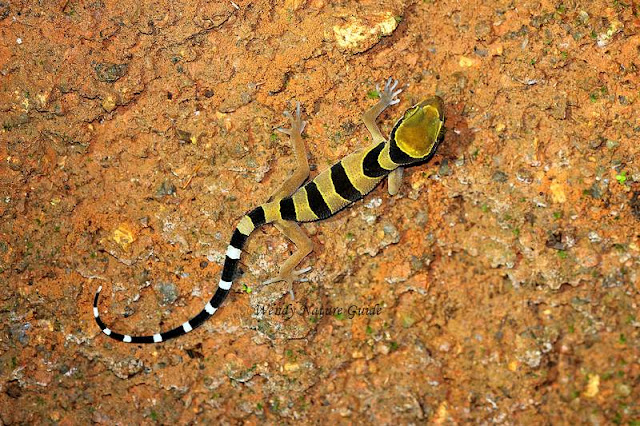My day today was filled with looking at genus Cyrtodactylus from the Gekkonidae family. On our fun night out for critter spotting with Kim and Mark Pennell, we stumbled upon two beautiful geckos that I have yet to identify. Flipping through pages of Indraneil's Field Guide to the Reptiles of South-East Asia (2010 publication), Beautiful Bent-Toed Gecko Cyrtodactylus pulchellus looks kinda fit my images at a glance.
 |
| Cyrtodactylus macrotuberculatus - maybe? |
A month ago, I saw a display of an image of a gecko which looks similar to my gecko photo and it was labelled as Cyrtodactylus langkawiensis. I was excited! Wow! Did we actually see an endemic species of gecko?
Wait a minute! Just to be sure, my first step was to check my only resource book and this langkawiensis is not listed. Next step was to ask Ms Google and I came upon images that led to a flickr album and to this website:
https://www.ecologyasia.com/verts/lizards/langkawi-island-bent-toed-gecko.htm
Then I realise that they look the same but something tells me that they have differences. To my untrained eyes looking at geckos, the best thing to do is to ask. I contacted someone who is into Herpetology and he has kind to give me the possible species name which is macrotuberculatus with its common name given as Gunung Raya Bent-Toed Gecko (Grismer & Ahmad, 2008). However, that book didn't have any illustration. But he said that it is only a possibility though it stands a high chance of a macrotuberculatus rather than the langkawiensis based on the dorsal. I was very much hoping it was the latter.
 |
| Cyrtodactylus macrotuberculatus - Not sure! |
It is not easy to identify a species from the photos. Geckos are more challenging than birds! Actually, waders are also challenging. After reading the descriptions of these two species of geckos I have found through online searches, the differences can only be seen by picking it up and doing detailed examination of its length, colouration of the dorsum, granular scales, size of tubercles, amount of ventral scales and more confusing stuffs! Its habitat is also taken into account too. As the saying goes, "Same same but different".
The conclusion is that I am convinced that the gecko we saw and photographed that night was not a Cyrtodactylus langkawiensis, which is endemic to Langkawi. And neither is a Cyrtodactylus pulchellus. According to the Field Guide to the Reptiles of South-East Asia (Das, I. 2010), Cyrtodactylus macrotuberculatus is endemic to the west coast of northern Peninsular Malaysia (Pulau Langkawi), however, recent findings of this species apparently have been recorded on the mainland too.
Thank you to the Herp guy for his time!
Thank you to the Herp guy for his time!
1. Das, I. (2010). A Field Guide to the Reptiles of South-East Asia. New Holland Publishers (UK), England. pp. 369
2. Grismer & Ahmad, 2008, Cyrtodactylus macrotuberculatus, Retrieved from
https://www.mybis.gov.my/sp/53743


No comments:
Post a Comment
Would love to hear from you. Please feel free to comment here.